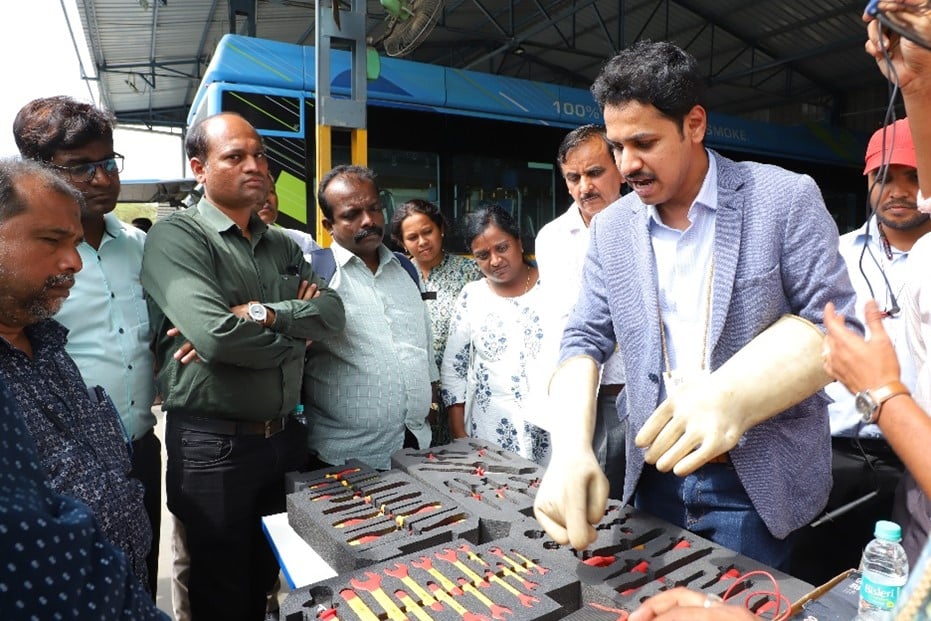
In the wake of the resounding success of the 2021 United Nations Climate Change Conference (COP26), India stands poised at the vanguard of a global commitment to combat climate change with sustainable mobility solutions. As the echo of the COP26 agreement in Glasgow reverberates, India’s dedication to a cleaner, more efficient transportation future becomes evident.
The rapidly increasing electric vehicle (EV) adoption, particularly electric buses, encapsulates this commitment and ushers in a transformative era of urban transportation. Driven by government schemes, legislation, domestic manufacturing capabilities, urbanization, and environmental awareness, India’s electric bus market is flourishing.
As of June 2022, EV sales, encompassing two-wheelers, three-wheelers, and four-wheelers, have witnessed an astounding 333% year-on-year increase. The electric bus segment, constituting 0.4% of the market share, achieved an impressive 220% surge in sales during the fiscal year 2022. ‘PM E-bus seva’ announced by the Central Government has set forth ambitious targets of deploying over 1000 electric buses in 169 Indian cities. Considering the nation’s ambitious electrification targets, evolving the current ecosystem for a safe and sustainable adoption of electric buses is of paramount importance.
The rapid integration of electric buses into urban mobility landscape has presented a crucial challenge pertaining to the fire safety. In year 2022, several electric two-wheeler and electric bus fire incidents have raised concerns regarding use of electric buses. While the intricate interplay of high-voltage systems and advanced lithium-ion batteries facilitates suitable range for urban operations, they are high risk components whose malfunctioning may lead to fire incidents. The implications of inadequate understanding, improper handling, and thermal incidents of the electric buses have led to several fire incidents around the globe.

Mitigation and prevention of E-bus fire incidents call for comprehensive understanding of the cause of fire. An investigation into cause of such incidents indicates that the central element of E-bus fire is the lithium-ion batteries (LIBs) that power these vehicles. The advanced technology of LIBs poses challenges associated with thermal management. Inadequate temperature control can trigger thermal runaway, a series of chemical reactions within batteries that can escalate into a battery fire. Vehicular collision is another key factor leading to electric bus fires Accidents involving E-buses, can damage battery systems, jeopardizing their structural integrity and elevating the risk of fires. Furthermore, the charging infrastructure may trigger the fire incidents though short circuits within charging stations that can lead to electrical failures. Effective thermal management emerges as a key measure for avoiding the E-bus fire incidents. A robust framework comprising of sophisticated cooling mechanisms, integrating thermal sensors, and adopting efficient heat dissipation techniques can be put in place to prevent thermal runaway in turn resulting in E-bus fire.
Minimising the possibility of E-bus fires necessitates a multifaceted strategy involving policy/ regulatory reform, battery design, colling technology and design of charging infrastructure. Overhauling the safety regulations is another crucial step towards preventing E-bus fires. This involves re-evaluating and strengthening existing standards governing battery design, temperature control, and crash resilience. Establishing standardized safety testing protocols for battery packs, charging systems, and other critical components is pivotal to ensuring consistent adherence. Incorporate flame-resistant materials and structures capable of withstanding collisions in battery design is essential step for arresting escalation of fires following accidents. Furthermore, innovative cooling systems capable of dynamically adjusting temperature conditions are pivotal for battery stability. Concurrently, bolstering the charging infrastructure by installing fault detection systems and rapid shutdown mechanisms to promptly address short circuits, is essential to diminish fire threats.
In the unfortunate event of an E-bus fire, swift and well-coordinated responses are necessary. establishing effective fire suppression systems that dispense appropriate extinguishing agents is critical for containing fire spread, minimizing damage, and safeguarding both passengers and rescuers. Key steps for extinguishing the electric bus fires are:
Additionally, standard emergency response protocols are indispensable for effective management, of the crew members, passengers, and first responders. Curated standard operating procedures for different set of stakeholders may be developed and targeting knowledge dissemination can be conducted to sensitise different set of responders regarding their role in the event of such incidents. Equipping stakeholders with the knowledge and resources required to handle E-bus-related incidents can aid substantially in ensuring the safety of all parties involved.
Robust training programs are an integral facet of fostering safer E-bus operations. The initial step involves conducting a comprehensive Training Needs Analysis (TNA) to identify knowledge gaps among drivers, maintenance personnel, emergency responders and range of other stakeholders. Tailored training courses that equip stakeholders with the skills needed to effectively manage fire hazards are imperative. Additionally, raising passenger awareness is vital. Passengers feel more secure when educated about emergency protocols, evacuation procedures, and their role in fire prevention. Depending on the type of stakeholder training/ awareness building may consist of one or more of the following modules:

As electric buses take centre stage in urban transportation, the promise of environmental and socioeconomic benefits is undeniable. The journey towards sustainable urban mobility is beyond mere technological innovation. It entails fostering a culture of safety and security to support this transformative shift. The path to a greener future must address the fire hazards pertaining to e-buses. This calls for creation of a reliant, responsive, and safe ecosystem with adequate knowledge, skills and resources to successfully navigate these challenges.
Promotion of Transformation to Sustainable and Climate-friendly Electric Mobility in India (E-mobility) implemented by GIZ and Ministry of Heavy Industries (MHI), GoI and funded by the German Federal Ministry for Economic Cooperation and Development (BMZ).
 Trainer describing the functions of the High Voltage tools used for electric bus maintenance © GIZ
Trainer describing the functions of the High Voltage tools used for electric bus maintenance © GIZ

Suraj Suresh Kanojia
suraj.kanojia@giz.de
Visit profile